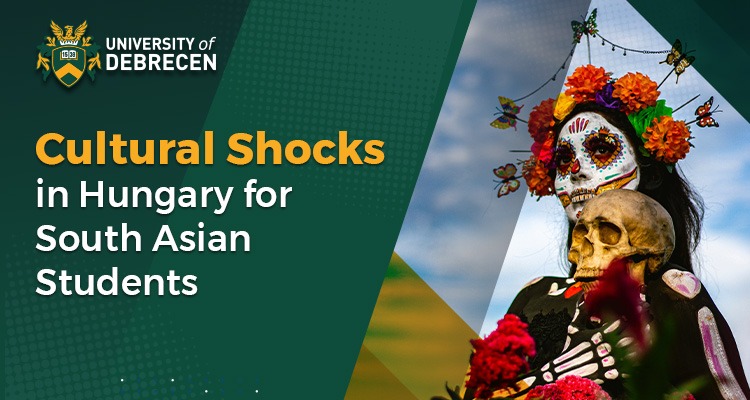Cultural Shocks in Hungary for South Asian Students

Laiba Obaid
15 min read
2 Comments
Table of Contents:
Culture in Hungary
Hungary and South Asia: A Comparative Overview
The Cultural Shock Experience
Conclusion
Culture in Hungary
Studying abroad is a dream cherished by many South Asian students drawn by the allure of exploring new horizons and experiencing different cultures. These students often see Europe as the ultimate destination due to its perceived higher quality of life. The students invest their heart and soul into their studies to meet European standards and pursue higher education opportunities in this continent. However, amidst the excitement of a life in Europe, a critical aspect often goes overlooked: the stark cultural contrast. As these intelligent minds set on their academic pursuit, they might face unexpected cultural shocks in Hungary.
This blog aims to shed light on the cultural shocks in Hungary that South Asian students might have to face. This blog will prepare and empower our international students with the necessary knowledge before they embark on this adventure. It will ensure a smoother study abroad journey and a deeper appreciation for Hungary's unique experiences.
Hungary and South Asia: A Comparative Overview
Before delving into the cultural shocks in Hungary that South Asian students may encounter, it is essential to understand the context. To establish that foundation let’s go through the historical and geographical distinctions between Hungary and the South Asian countries.
Hungarian Culture and Traditions
The histories and cultural backgrounds of Hungary and South Asia offer intriguing contrasts and unique identities. Hungary's history has been shaped by significant territorial losses, particularly after World War I. The country faced isolation due to its distinct language and geographical position. Despite challenges and foreign rule, Hungary maintained its political identity and partnered with Austria-Hungary for several decades. This historical context fostered a defensive attitude towards Western Christianity and a desire for recognition from the West. Budapest, the capital city, historically dominated Hungary, but recently, the city of Debrecen has risen as a thriving business and industrial hub.
South Asia, on the other hand, is known for its diversity and rich cultural heritage. South Asia features a varied landscape, with the Indo-Gangetic Plain and peninsular India being prominent geographical features. The region's history dates back to ancient civilizations, such as the Indus civilization. It is home to one of the world's earliest known literary traditions in languages like Sanskrit and Prākrit. Despite political fragmentation, South Asia shares a common cultural and ethical outlook, evident in music, dance, rituals, and literature.
While Hungary's history has been marked by territorial losses and a search for identity, South Asia's history has a rich tapestry of civilizations and languages, contributing to a shared cultural heritage. Both regions have faced unique challenges that influenced their collective psyche and shaped their contemporary social, political, and cultural landscapes. These historical and cultural backgrounds will continue to play a vital role in shaping the identities of the two regions. The knowledge of these aspects of society will help South Asian students to understand the cultural shocks in Hungary.
Culture in Budapest
In Budapest, South Asian students can immerse themselves in a cultural tapestry that weaves together a rich historical legacy and vibrant modernity. The city's architecture, from the medieval Buda Castle to the iconic Parliament Building, tells a story of centuries past. Thermal baths, a tradition rooted in Ottoman history, provide a relaxing escape, while Hungarian cuisine offers a delightful fusion of flavors, from hearty goulash to sweet chimney cakes.
Throughout the year, Budapest hosts a variety of cultural events and festivals, providing students with opportunities to engage in the city's dynamic arts scene. The nightlife, ranging from ruin bars to trendy clubs, ensures an energetic social atmosphere. While Hungarian is the official language, English is widely spoken, contributing to a welcoming environment for international students.
As South Asian students embark on their academic journey in Hungary, Budapest invites them to embrace its cultural kaleidoscope, fostering a deeper understanding of both the city's heritage and its contemporary vibrancy.
Climate of Hungary:
Hungary and South Asia have contrasting climates due to their geographical locations and topographical differences. Hungary, situated within the Carpathian Basin, experiences a moderately dry continental climate with distinct seasons and moderate precipitation levels. Winters are cold, while summers are warm. In contrast, South Asia's climate is incredibly diverse, ranging from the cold highlands of the Himalayas to the tropical wet regions along the coasts. Monsoons heavily influence the region, bringing seasonal winds and significant rainfall. The differences in climate between Hungary and South Asia highlight the variability of climate patterns across different regions of the world. South Asian expats should keep these geographical factors in mind to avoid cultural shocks in Hungary.
The Cultural Shock Experience
South Asian students will likely encounter a series of cultural shocks in Hungary that might initially catch them off guard. However, as time passes and South Asian students embrace the distinctiveness of Hungarian culture, they will likely find themselves enriched by the experience. Below, we will delve into each cultural shock that South Asian students might encounter in Hungary, offering a brief explanation to help them in coping with cultural differences in Hungary.
Religious values:
The religious values of Hungary and South Asia demonstrate significant differences and historical contexts that have shaped their respective religious landscapes. In Hungary, the country claims no official religion and guarantees religious freedom. The dominant religious groups are Roman Catholic, Calvinist, and Lutheran, with smaller communities of various Christian denominations and Jewish believers. Hungary's religious history has been shaped by periods of struggle with communist rule during which the state was officially atheistic.
In contrast, South Asia has a rich and diverse religious history dating back thousands of years. The region has seen the rise of various religious movements, including the Indus Valley culture, Vedic culture, and the emergence of Hinduism, Buddhism, Jainism, and Islam. South Asian religions are characterized by complex philosophical and spiritual traditions with deep spiritual concepts like karma, samsara, rebirth, etc.
While Hungary has experienced relatively recent changes in its religious landscape due to historical events like communism and its aftermath, South Asia's religious values have been shaped over millennia by diverse philosophical and spiritual traditions. These differences might come as a cultural shock in Hungary to South Asian students.
Social Customs and Etiquette
Social norms and etiquette play a significant role in daily interactions. In Hungarian culture, handshakes are a customary way of greeting, symbolizing respect and establishing rapport. Maintaining eye contact is essential, as avoiding it might be perceived as evasive or suggestive of concealing something. Close friends often greet each other with a friendly kiss on the cheek, reflecting a warm and familiar relationship.
Social norms and etiquette play a significant role in daily interactions. In Hungarian culture, handshakes are a customary way of greeting, symbolizing respect and establishing rapport. Maintaining eye contact is essential, as avoiding it might be perceived as evasive or suggestive of concealing something. Close friends often greet each other with a friendly kiss on the cheek, reflecting a warm and familiar relationship.
Expats should be aware of the cultural shocks in Hungary to avoid misunderstandings. Even though handshakes are standard, it is customary to wait for women to initiate the gesture. This demonstrates cultural sensitivity and respect for the traditional values upheld in Hungarian culture.
As the two nations differ significantly in their social norms and etiquette, so cultural nuances are bound to arise. Understanding and adapting to the cultural shocks in Hungary will be essential for a smooth and respectful integration into Hungarian society.
Communication Style
Communication styles in South Asia and Hungary exhibit significant differences due to their unique cultural backgrounds. It can put international students into multiple cultural shocks in Hungary.
In South Asia, communication is characterized by its indirect, implicit, polite, and formal nature. The communication style emphasizes the cultivation of modesty, humility, and harmonious relations with others. Asians value the interdependent self, where one's self-concept and self-esteem are heavily influenced by how they are perceived by others within their kinship networks. A positive self-image is projected by maintaining good relations with others, working in a team, and having a supportive social network. This leads to a great deal of sensitivity in protecting the other party's positive image or face during communication. Respecting social hierarchies and showing consideration to others is encouraged in Asian cultures.
In contrast, Hungary, being a Western society, places more emphasis on assertive verbal skills, promoting self-expression and public speaking. Unlike Asian societies, the independent self is valued, and individuals are viewed as autonomous beings with unique personalities, emotions, and motivations. Hungarian communication is less formal and may lack the same level of politeness as in South Asian cultures. These cultural disparities in communication styles might come as a cultural shock in Hungary for South Asian students.
Food and Cuisine
Cultural shocks in Hungary for South Asians, particularly regarding food and cuisine, can be quite striking due to the stark differences in culinary traditions and flavors. South Asian cuisine, originating from the Indian subcontinental region, is rooted in a history that dates back thousands of years. It is a blend of various influences, including Hindu and Muslim practices. Dishes are often highly flavored, incorporating ingredients like eggplants, rice, wheat, and tamarind.
On the other hand, Hungarian cuisine, influenced by a diverse history of conquerors and settlers, offers a unique amalgamation of culinary elements. The Magyars brought with them a nomadic lifestyle and a preference for hearty, robust stews and soups prepared in cast-iron cauldrons. Over the centuries, Hungary's cuisine evolved as it embraced influences from Italy, Turkey, Austria, and Germany.
The focus on meat, especially pork, is prominent in Hungarian dishes. South Asian cuisine, on the other hand, often features a diverse range of vegetarian options. The use of ingredients such as dill, caraway, and marjoram in Hungarian dishes may be unfamiliar to South Asians, who commonly use spices like cumin and turmeric in their cuisine. Additionally, Hungarian cuisine incorporates goose liver and the Hungarians love cakes and pastries which reflects European influences. These characteristics set the local cuisine apart from the sweet and savory combinations often found in South Asian food.
While South Asians may initially experience cultural shocks in Hungary due to its cuisine, the diversity of flavors and cooking techniques ultimately creates a unique culinary experience. Exploring and embracing these differences can lead to a deeper appreciation of the rich cultural tapestry of both regions.
Attire
Cultural shocks in Hungary for South Asians, specifically related to dressing and fashion, can be quite distinct. There is a stark contrast between the traditions and history of the attire of South Asian countries and Hungary. The dynamic evolution of Hungarian fashion is worth knowing about if you are moving to the country.
In South Asia, draped and wrapped garments are prevalent, with the sari being the most typical form of women's dress. For men, the dhoti is widely worn. The attire in the region reflects a common cultural heritage. While some Western clothing is adopted, traditional dress is still maintained, especially for special occasions and by the older generations.
In contrast, Hungary's fashion scene has undergone significant changes over the years. In 2023, casual clothing in Hungary is a typical European style of dress, casual or smart casual attire suitable for most occasions. Jeans are a popular and versatile base for one's wardrobe as it is easily adaptable to different seasons. It is topped with lighter camisoles or t-shirts in the summer and warmer long-sleeved tops with sweaters in the winter.
South Asian students should expect these cultural shocks in Hungary in the realm of dressing and fashion. However, they should embrace these differences as they highlight the rich diversity and uniqueness of each region's sartorial traditions. As cultural boundaries blur and global influences shape fashion trends, both regions contribute to the vibrant tapestry of world fashion. It celebrates their distinct histories while embracing the ever-changing currents of modern style. This exchange fosters mutual appreciation and enriches the global fashion landscape.
Final Words about Culture in Hungary
In conclusion, studying abroad in Hungary can be a transformative experience for South Asian students. But it also comes with its fair share of unexpected challenges in the form of cultural shocks in Hungary. Understanding the social, and cultural distinctions between the two regions is crucial for navigating these differences with sensitivity and respect. As students set on their journey to Hungary, they should be prepared for diversity, and keep an open mind. Encountering culture in Hungary may initially be overwhelming. However, it is through these encounters that students can truly grow, learn, and broaden their perspectives. Ultimately, overcoming these cultural challenges will not only enrich their study abroad experience but also shape them into global citizens with a broader outlook on life.
FAQs
What are some of the cultural shocks that South Asian students might encounter in Hungary?
South Asian students might experience cultural shocks in Hungary related to religious values, social customs and etiquette, communication styles, food and cuisine, and attire.
What can South Asian students expect from Hungarian cuisine and how does it differ from their traditional food?
Hungarian cuisine focuses on meat, especially pork, and incorporates unique flavors like dill and caraway. This differs from the diverse vegetarian options and spicier flavors commonly found in South Asian food.
How has Hungarian fashion evolved, and what attire is typical for everyday wear?
Hungarian fashion has seen significant changes over the years, with casual or smart casual attire being typical for everyday wear. Jeans and light tops are popular in summer, while long-sleeved tops with sweaters are worn in winter.
How does the communication style vary between Hungary and South Asia?
In Hungarian culture, communication is more assertive and direct, while South Asian communication tends to be more indirect and implicit, emphasizing harmony and modesty.
What are some tips for South Asian students to adapt to the communication style in Hungary?
South Asian students can adapt to Hungarian communication styles by being more assertive in expressing themselves, maintaining eye contact, and being mindful of the directness in conversations.

